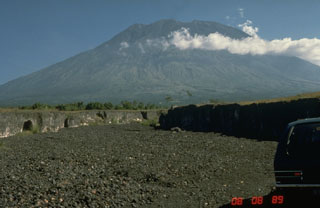Report on Agung (Indonesia) — 13 September-19 September 2017
Smithsonian Institution / US Geological Survey
Weekly Volcanic Activity Report, 13 September-19 September 2017
Managing Editor: Sally Sennert.
Please cite this report as:
Global Volcanism Program, 2017. Report on Agung (Indonesia) (Sennert, S, ed.). Weekly Volcanic Activity Report, 13 September-19 September 2017. Smithsonian Institution and US Geological Survey.
Agung
Indonesia
8.343°S, 115.508°E; summit elev. 2997 m
All times are local (unless otherwise noted)
Increased seismicity at Agung, as well as the severity of past eruptions, prompted PVMBG to raise the Alert Level to 2 (on a scale of 1-4). The report noted that volcanic earthquakes (VA) began to be recorded on 10 August and shallow volcanic earthquakes (VB) began to be recorded on 24 August. Local tectonic earthquakes were also recorded and began to increase consistently on 26 August. PVMBG warned the public to stay at least 3 km away from the crater. On 13 September a climber observed a sulfatara plume rising from the bottom of the crater as high as 50 m above the crater rim. During 14-18 September four earthquakes centered around Agung were felt. On 18 September PVMBG reported that the number of VA and VB events continued to increase; the Alert Level was increased to 3. The exclusion zone was increased to 6 km, with an additional expansion to 7.5 km in the N, SE, and SSW directions. Elevations above 950 m were also restricted.
A VEI 5 eruption during 1963-64 produced pyroclastic flows and lahars that caused extensive damage and resulted in more than 1,100 deaths.
Geological Summary. Symmetrical Agung stratovolcano, Bali's highest and most sacred mountain, towers over the eastern end of the island. The volcano, whose name means "Paramount," rises above the SE rim of the Batur caldera, and the northern and southern flanks extend to the coast. The summit area extends 1.5 km E-W, with the high point on the W and a steep-walled 800-m-wide crater on the E. The Pawon cone is located low on the SE flank. Only a few eruptions dating back to the early 19th century have been recorded in historical time. The 1963-64 eruption, one of the largest in the 20th century, produced voluminous ashfall along with devastating pyroclastic flows and lahars that caused extensive damage and many fatalities.
Source: Pusat Vulkanologi dan Mitigasi Bencana Geologi (PVMBG, also known as CVGHM)

